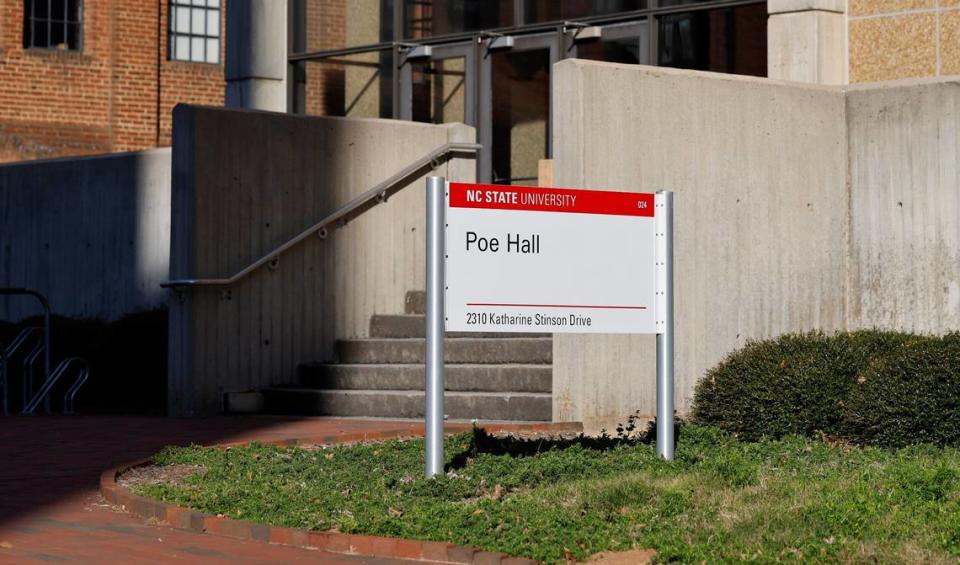With investigations at Poe Hall, UNC Lab, what does it take to find a cancer cluster?
Federal health officials are investigating whether exposure to hazardous materials at a pair of Triangle-area university buildings could have caused cancer among employees.
The National Institute of Occupational Safety and Health is investigating N.C. State’s Poe Hall and UNC Health’s McClendon Laboratories to determine whether there is an increased risk of cancer at the two workplaces and from there whether materials found in those workplaces could be playing a role.
But proving that suspicions are actually evidence of a cancer cluster is difficult, with researchers sifting through slippery data as they try to determine whether a community’s concerns are valid. We talked with North Carolina experts to see why that is the case.
“It’s a high bar to clear, not because the definition is so strict but just because the data are really often not there to allow you to really make that determination,” Dr. Zack Moore, North Carolina’s state epidemiologist, told The News & Observer.
What is a cancer cluster?
The U.S. Centers for Disease Control and Prevention defines a cancer cluster as a greater-than-expected number of cancer cases that are either the same, similar or have similar causes. Those cases must occur among a similar group of people in a defined geographic area over a defined period of time.
For instance, an abnormally high number of childhood cancer cases in Clyde, Ohio, from 1996 to 2010 led to the official label of a cancer cluster. That resulted in an investigation that eventually discovered a significant amount of polychlorinated biphenyls, a probable human carcinogen, in the soil at a recreational park that had been owned by Whirlpool.
No cancer clusters have been proven in North Carolina, although there has been significant community suspicion in recent years about thyroid cancer cases in Iredell County and ocular melanoma cases in Huntersville.
How do you prove it?
When a group of people or a doctor report a suspected cancer cluster in North Carolina, it goes to the state’s Central Cancer Registry. Even those reports are relatively rare.
“We believe it’s important to investigate those concerns that do come to us. We know that they very rarely are going to lead to linking cancers to a specific exposure,” Moore said.
The registry looks at the rate of a suspected cancer in a given area and determines if it’s higher than expected. If the number of cases is suspiciously high, CDC guidelines say state health officials would next consider:
Whether the rate of cancer is significantly different in the area being studied than a comparison area.
Whether the rate has increased over time or spiked over a certain period.
Whether there is an increase or a pattern in deaths among people diagnosed with cancer.
If any of those questions show a pattern, health officials would look at diagnoses to see if the cases are clustered geographically or if the people reporting certain kinds of cancers share environmental risk factors like drinking from the same water system or living downwind of a certain factory.
Next, the CDC recommends that health officials work with environmental agencies or the U.S. Agency for Toxic Substances and Disease Registry to evaluate potential sources of exposure and determine if they align with the observed patterns of cancer diagnoses.
Why are cancer clusters hard to confirm?
Gaps in data make it extremely difficult for health officials to confidently evaluate whether something that appears to be a pattern of cancers actually is one, Moore said.
Part of that is the information included in North Carolina’s cancer registry.

When a cancer diagnosis is reported to the registry, the address that is used is the place where the person is living at the time. That omits the rest of a person’s history and doesn’t account for potential exposures.
“You might live in Wake County when you’re diagnosed, but you were living in Brunswick County for 20 years, just as an example,” Moore said.
A doctor making a cancer diagnosis is unlikely to review a patient’s entire life history to see where they might have been exposed to a cancer risk, Moore said. If a doctor did ask for that data, Moore added, it wouldn’t be recorded in the state’s cancer registry.
Understanding that history is important because of the way cancer develops. Different kinds of cancers have different latency periods — the time between the initial exposure to something and when the disease it has caused is found. These are typically measured in years and often in decades.
Figuring out if a cancer rate is higher than expected can be difficult, said Andrew Olshan, a UNC-Chapel Hill cancer epidemiologist.
In cases like a school or a workplace where a cluster is suspected, determining both the number of diagnosed cancer cases and the number of total people who passed through the building is challenging, Olshan said.
From there, it is harder still to ascertain who was in the building and potentially exposed to a carcinogen.
“You don’t know about people who have died — maybe of cancer maybe not — or people who don’t work there anymore and didn’t get the message,” Olshan said, noting that most cancer cluster investigations in workplaces begin with employees growing suspicious about seemingly related diagnoses that come in quick succession.
If health officials are able to figure out the number of cases linked to a building and the number of people who were there, tying the cases to a particular exposure is difficult.
Doing that is easiest in a setting like a factory, Olshan said, where people are exposed to the same materials consistently over the course of years. Researchers can see if there’s a risk factor in those materials and evaluate the workers for different biomarkers and health outcomes over a period of time.
It is tremendously difficult in a setting like a school building, where people may have been exposed to something but then quickly scattered.
“This, to me, is one of the most challenging circumstances because it has all of these things that often are not controllable that are all sources of uncertainty and potential bias,” Olshan said.

What’s happening at Poe Hall?
Poe Hall, which was built in 1971, housed N.C. State’s College of Education and psychology department.
The school started investigating Poe Hall in August after someone raised a concern about air quality during a renovation project. By October, N.C. State officials had asked DHHS for help evaluating breast cancer cases potentially linked to the building.
DHHS suggested that the school work with NIOSH, which often evaluates concerns about cancer in workplaces.
In mid-November, after receiving lab results that showed levels of a certain PCB to be high, the EPA recommended removal, and N.C. State closed Poe Hall. Chancellor Randy Woodson recently announced the closure is likely to remain in effect for the rest of the year while the school evaluates environmental hazards in the building and NIOSH conducts a Health Hazard Evaluation.
What’s happening at McClendon Clinical Laboratories?
NIOSH is also conducting a Health Hazard Evaluation at UNC’s McClendon Clinical Laboratories, a facility located on the first floor of UNC Medical Center.
That investigation started in January, ABC11 reported, after someone told the health system that at least four current employees and possibly as many as a dozen former employees had been diagnosed with cancer in the last 20 years. UNC Health told ABC11 that more than 1,000 people have worked in the lab over the past 20 years.
How often do health hazard investigations find cancer clusters?
Virtually never.
It is extremely uncommon for NIOSH’s Health Hazard Evaluations to find cancer clusters, and even more rare for those clusters to be attributed to a particular source.
NIOSH evaluated 170 workplaces for cancer concerns between 2001 and 2020, finding clusters in only seven, according to a peer-reviewed study NIOSH researchers recently published in the journal Occupational & Environmental Medicine.
Investigators did not link an occupational hazard to cancer in any of the seven workplaces where they did identify clusters, the study said.
“In these community workplace settings it can sometimes be unsatisfying to everybody involved because there’s a legitimate concern raised and the epidemiological and statistical methodology kind of leave the story hanging,” Olshan said..
In reversal, NC State and CDC agree on new Poe Hall health investigation, chancellor says
Are cancer cluster investigations still worth it?
Even if a final determination of a cancer cluster is unlikely, Moore believes that researching a cohort and determining potential exposures can have real benefits for public health.
Moore used the example of a building that is being investigated for a suspected cluster. Even if that investigation doesn’t yield a direct link to elevated cancer risk, it could reveal a contaminant or similar threat to human health.
“There are steps you can take to reduce or eliminate that exposure,” Moore said. “That’s going to help the people who are in that setting even if you’re not able to draw a clear linkage between that exposure and the cancers.”

What work is happening in North Carolina?
State Sen. Vickie Sawyer, an Iredell County Republican, represents a district that has grappled with concerns about cancer clusters for years, with many linking cases to coal ash.
Last session, Sawyer introduced a bill that would have hired cancer cluster investigators and educators at the N.C. Collaboratory. That would have included a cancer epidemiologist who would have responded to public concerns about potential clusters and proactively evaluated cancer incidences. It also would have included a public health educator and staff who would have worked directly with physicians.
The data is key, Sawyer said, particularly in something as challenging as evaluating cancer clusters.
“It’s really tough to prove this, but it’s important work to be done because we need to know if there is something in the environment that is causing people to become sick,” Sawyer said in an interview.
As part of that legislation, Sawyer also called for the state’s cancer data collection to be more uniform to ensure that doctors are reporting cases when they are diagnosed, not at various points in the treatment.
That legislation failed to advance out of committee, as did a similar effort in 2022.
Both bills grew out of a 22-researcher panel Olshan chaired in 2019 that looked at how North Carolina could improve its cancer cluster reporting and research capabilities.
Now, Olshan is part of a Collaboratory team working to evaluate thyroid cancer rates and analyze how they compare to the distribution of hazardous waste sites and air pollution across North Carolina.
Olshan hopes to complete the study by summer 2025 and wants it to serve as a model for how state health officials could evaluate future worries about cancer clusters.
It is unlikely that the study will find a causal link between some kind of hazardous waste site or air pollution and the Iredell County cancer cases, Olshan said. But he hopes that it can at least narrow the possibilities for people who have been seeking answers for more than five years.
“They’ve been calling for more action and more study for years and hopefully we at least do something the best we can to start to address their questions and concerns,” Olshan said.
NC Reality Check is an N&O series holding those in power accountable and shining a light on public issues that affect the Triangle or North Carolina. Have a suggestion for a future story? Email realitycheck@newsobserver.com
This story was produced with financial support from the Hartfield Foundation and Green South Foundation, in partnership with Journalism Funding Partners, as part of an independent journalism fellowship program. The N&O maintains full editorial control of the work. If you would like to help support local journalism, please consider signing up for a digital subscription, which you can do here.

